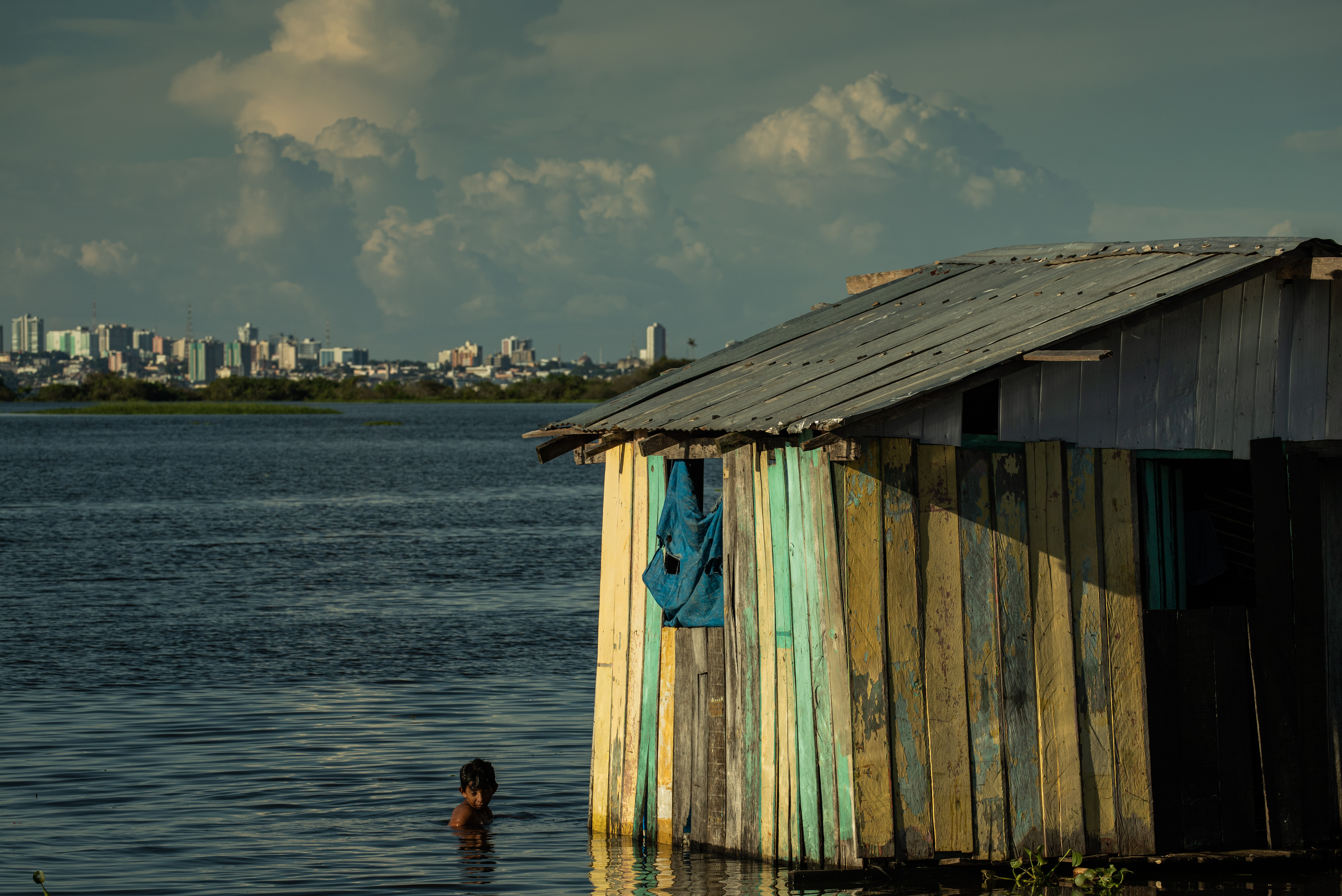Climate Misinformation Is About More Than Denialism
Lies, misconceptions, and propaganda about intensifying climate change and policy responses will increasingly shape security and geopolitics.

Published by The Lawfare Institute
in Cooperation With

In May, southern Brazil experienced devastating flooding that killed more than 160 people, displaced 600,000 residents, and drew in the military for a lengthy recovery. It was another harbinger of our age of climate insecurity. But despite likely scientific explanations, recovery was complicated by misinformation attributing the disaster to a global conspiracy involving a U.S. scientific installation in Alaska and chemical spraying from jet aircraft.
The incident illustrates a broader intersection of climate change, misinformation, and security—as Brigitte Hugh and I highlight in a recent paper. Climate change is bringing unprecedented heat, drought, and other forms of extreme weather, with corresponding disruptions to security. Meanwhile, necessary climate policies, though salutary, pose their own socioeconomic and geopolitical challenges. Intensifying climate impacts, and the policy responses that must accompany them, create openings for bad actors to spread mis- and disinformation, affecting climate policy and undermining security.
The challenge of climate mis- and disinformation is broader than denialism or opposition to clean energy.
The spread of false or misleading information also exacerbates climate change’s direct impacts—like food and water insecurity, displacement, and destruction of infrastructure. These cases can prompt misinformation that scapegoats certain populations for disasters, undermines recovery, or merely exploits disorder and media attention in unrelated disputes. The distribution of this information also contributes to cascading consequences of climate disruptions. It can stoke backlash to climate-driven migration or further discredit fragile governments struggling with climate strains. This spread of harmful information could also exacerbate potentially underappreciated risks from necessary climate policies, whether stirring social unrest over economic turmoil in petrostates, mobilizing competing interests in land use conflict, or intensifying geopolitical competition over clean energy and climate finance.
These issues are not theoretical; they are unfolding today. Physical climate disruptions are giving state and non-state actors avenues to malign marginalized communities and foreign adversaries, including through mis- and disinformation. Last year after wildfires killed more than 100 individuals in Maui, Russia suggested aid for Ukraine had left Hawaii vulnerable, and China falsely attributed the disasters to an experimental U.S. weather control weapon. During other wildfires that took place in 2021, Turkish state media focused on alleged arson by the Kurdish PKK, Greek far-right actors scapegoated Afghan migrants, and the Algerian government blamed an alleged conspiracy of Israel, Morocco, and domestic opponents. And as climate change threatens shared water resources, states have deployed mis- and disinformation to shape public opinion and bolster their negotiating positions—such as covert efforts by Egypt to undermine support for the Grand Ethiopian Renaissance Dam or by China to undermine Mekong River transparency initiatives.
Many entities, including governments and individuals, are also seeking to use mis- and disinformation to take advantage of migration. This is important with respect to climate change for at least two reasons. First, climate change is projected to increase migration and displacement. Second, some of the false and misleading information related to migration that has circulated invokes unfounded climate or environmental justifications.
Turkish electoral candidates have fueled xenophobic misinformation about Syrian refugees that has motivated violence; Russia has stoked U.S. backlash to migration seemingly to undermine U.S. support for Ukraine; and Belarus has facilitated irregular migration to other countries in Europe from climate-vulnerable regions to retaliate for EU sanctions, and subsequently spread propaganda denouncing Polish, Latvian, and Lithuanian treatment of migrants in the resulting crisis. Non-state actors such as U.S. border militias that may deny human-caused climate change still mobilize over ill-founded security fears of migrants from Central America, where a recent study showed local drought appears to have accounted for approximately 70 percent more migration to the U.S. from 2012 to 2018. And eco-fascists attack minority populations and immigrants on the pretext of environmental conservation. This is an inversion of the facts—minority and immigrant populations tend to produce fewer emissions, are responsible for proportionately less pollution, and express greater concern about climate change than white counterparts. Nevertheless, supposed environmental concern has figured in mass violence like the 2019 El Paso, Texas, killing of 20 people, which invoked a “Hispanic invasion of Texas.”
As climate change amplifies economic and governance weaknesses in climate-vulnerable states, the resulting fragility is providing more opportunities for states and individuals to spread false or misleading information to advance their objectives. According to one study, disinformation campaigns in Africa—including in many fragile and climate-vulnerable states—have almost quadrupled since 2022, perpetrated by domestic politicians and militaries, non-state extremists, and Chinese, Russian, and other foreign actors.
Further, recent events underscore how a range of actors can use misinformation to exploit or undermine well-intentioned climate policies, driving polarized and authoritarian politics. If beneficial and necessary climate policies inadequately account for affected populations, they can create real or perceived winners and losers—which itself can lead to the spread of false or misleading information.
For example, threatened petrostates and carbon-intensive businesses greenwash their policies and stonewall clean energy initiatives. Disruptive farmer protests against agriculture policies in the EU Green Deal have cited a mix of legitimate objections and misinformation, and Russian state media has boosted these claims to divide Europe and undermine aid to Ukraine. Meanwhile, nonviolent civil disobedience demanding faster climate action in Europe has been met by far-right accusations that have misleadingly equated protest with terrorism, contributing to polarization and violence.
Mis- and disinformation is playing a role in climate geopolitics as well, such as strategic competition over critical minerals supply chains and climate-vulnerable allies. In 2021 and 2022, China aided a Zimbabwean crackdown on local media criticism of the environmental impacts of Chinese lithium mining and other businesses, portraying it as a U.S.-led plot. This comes as the U.S. intelligence community has warned China is seeking to cast doubt on U.S. leadership and extend its influence with climate-vulnerable Indo-Pacific states. Additionally, the emergence of geoengineering to combat global warming raises disinformation-related risks, as highlighted by the unfounded claims that Emirati cloud-seeding caused damaging floods in April that closed Dubai’s airport and killed 18 individuals in neighboring Oman.
Unfortunately, climatic, societal, and technological trends suggest the challenge of climate mis- and disinformation is here to stay. Climate change is projected to worsen through the middle of the century in even the most optimistic emissions scenarios, nearly guaranteeing that 2040 will see a warmer and more volatile climate than today. Meanwhile, the evolution of increasingly dire climate dangers means policies needed to hold emissions at any given level must be more abrupt, portending a volatile energy transition and polarizing policy debates that bad actors can exploit. Compounding the problem, climate misinformation is part of larger dysfunction in the information ecosystem, and trends in key variables like societal trust and technology do not promote optimism. Polling shows public trust in governments, businesses, scientists, and journalists regarding climate change is declining around the world, and substantial minorities hold worrisome views—19 percent of adults in the United States and 30 percent in India believe “net-zero policies are a globalist conspiracy to destabilize” their countries. Meanwhile, social media companies moderate climate misinformation unevenly, and generative artificial intelligence has eased the production of falsehoods and enabled bad actors to more pervasively sow doubt in even authentic content.
There is room to mitigate these challenges by more proactively countering bad actors, anticipating misinformation in climate policy design, and filling knowledge gaps. To start, it would be helpful to conceptualize these manifestations of climate misinformation as a linked, growing challenge. Diplomats, national security officials, and social media companies in the developed and developing worlds should adopt broader and more cooperative efforts to inoculate against, monitor, and counter climate-related misinformation—including by learning lessons from efforts to counter election interference or false public health narratives. Meanwhile, energy and climate policymakers should more routinely take into account how their plans might produce valid or ill-founded fears that could be weaponized by disinformation peddlers, and design policies and communications plans accordingly. Researchers can help policymakers understand the most concerning vectors of climate misinformation, learn lessons from other misinformation challenges, identify the most promising interventions, and act more broadly to promote a resilient information ecosystem. With the scope of climate misinformation’s danger in full view, there is no time to waste.





